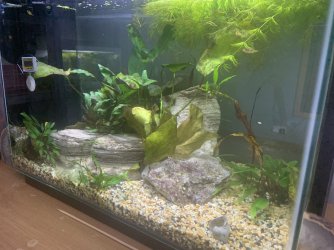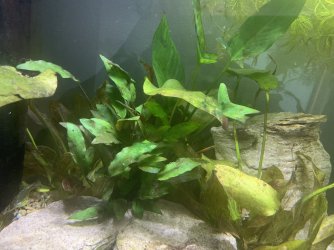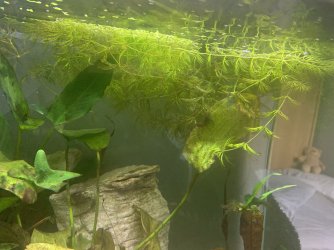My tank is 15 gallons and currently houses 4 juvenile pea puffers. I have several plants in the tank with them, including anubias hastifolia, cyperus helferii, microsorum pteropus, hygrophila pinnatifida and echinodorus ozelot red and a bunch of hornwort. So my issue is they become algae covered and the leaves all start to die off and every week I remove bunches of hornwort which is just dead and covered in algae. The microsorum flourishes, for some unknown reason but the rest fails. However, I have a 5 gallon which houses a single betta and a mix of snail species where the plants flourish and I am constantly having to trim them back. Could this have to do with filter flow blowing onto the plants? I do weekly 50% water changes and have experimented with changing the amount of time my tank lights are on, which is about 10 hours a day currently. I have never used ferts or CO2 but I am up for suggestions. Could anyone help me out?
You are using an out of date browser. It may not display this or other websites correctly.
You should upgrade or use an alternative browser.
You should upgrade or use an alternative browser.
Why do my plants always fail to grow...
- Thread starter JxsPxxle
- Start date
The October FOTM Contest Poll is open!

🏆 Click to vote! 🏆
Understanding "why" is important to resolving problems, so I'll start with the basics.
Plants require light that is of an intensity and spectrum sufficient to drive photosynthesis (this is how they grow). They also need 17 nutrients. If any one of these factors is not adequate or sufficient, photosynthesis will slow and may cease, depending. Faster-growing plants need more (brighter) light and more nutrients than slower-growing species. When this light/nutrient balance is out, algae takes advantage.
First we need some data on the light, be as specific as you can. Type, wattage, spectrum, etc.
Fish feeding and water changes can supply these nutrients, but usually not in sufficient amounts depending upon the fish load and plant species/numbers. You are not using any fertilizer you said, so that is almost certainly an issue, but before jumping into that (which can make algae even worse) we need to sort out the light.
Plants require light that is of an intensity and spectrum sufficient to drive photosynthesis (this is how they grow). They also need 17 nutrients. If any one of these factors is not adequate or sufficient, photosynthesis will slow and may cease, depending. Faster-growing plants need more (brighter) light and more nutrients than slower-growing species. When this light/nutrient balance is out, algae takes advantage.
First we need some data on the light, be as specific as you can. Type, wattage, spectrum, etc.
Fish feeding and water changes can supply these nutrients, but usually not in sufficient amounts depending upon the fish load and plant species/numbers. You are not using any fertilizer you said, so that is almost certainly an issue, but before jumping into that (which can make algae even worse) we need to sort out the light.
AbbeysDad
Fish Gatherer
+2 on a modest addition of a liquid fertilizer. Also, you may need to cut back on the light as 10 hours a day is likely too much and favors the algae. So add some fertilizer and with a timer, cut the light back to say 6 hours and go from there.
The tank brand is “Aqua” and it has a built in 10W LED light. I feed my dwarf puffers a 1/8 of a cube of frozen blood worms once per day.Understanding "why" is important to resolving problems, so I'll start with the basics.
Plants require light that is of an intensity and spectrum sufficient to drive photosynthesis (this is how they grow). They also need 17 nutrients. If any one of these factors is not adequate or sufficient, photosynthesis will slow and may cease, depending. Faster-growing plants need more (brighter) light and more nutrients than slower-growing species. When this light/nutrient balance is out, algae takes advantage.
First we need some data on the light, be as specific as you can. Type, wattage, spectrum, etc.
Fish feeding and water changes can supply these nutrients, but usually not in sufficient amounts depending upon the fish load and plant species/numbers. You are not using any fertilizer you said, so that is almost certainly an issue, but before jumping into that (which can make algae even worse) we need to sort out the light.
The tank brand is “Aqua” and it has a built in 10W LED light. I feed my dwarf puffers a 1/8 of a cube of frozen blood worms once per day.
Dwarf puffers (there are two species, Carinotetraodon travancoricus and C. imitator) are primarily freshwater so I will assume you are not adding sodium chloride (aquarium or marine salt) to the water since you have not indicated this (salt can affect plants though that is not what I am seeing in the photos here).
We will have to let the light pass, and trust it is sufficient. The lack of nutrients is probably the main issue. You want a comprehensive supplement which will ensure all necessary nutrients are present. Brightwell Aquatics FlorinMulti is ideal, and another is Seachem's Flourish Comprehensive Supplement for the Planted Aquarium. As you are in the UK, there is another much the same, TNC Lite; this came up in another thread and from my review it seems a good product, just make sure it is the TNC Lite and not the Complete. Follow the directions on the respective label.
I would also suggest reducing the light duration from 10 hours down to 8.
As you mention feeding bloodworms, this is not a good food for more than once a week. Try to get the puffers onto other foods, such as frozen shrimp and frozen bloodworms. Snails (the small harmless ones) are also good.
I agree. Bloodworms are very fatty. Snails are really good for pea puffers, as they help keep their beaks sharp. 

The only issue I have with snails is I only have one other tank which I occasionally get trumpet snails and bladder snails breeding but usually the eggs just get eaten. They never increase in numbers fast enough to keep up with my hungry puffers!I agree. Bloodworms are very fatty. Snails are really good for pea puffers, as they help keep their beaks sharp.
You should make a separate snail only tank. Breed the snails in there. After they get fairly big, feed them to your pea puffers.The only issue I have with snails is I only have one other tank which I occasionally get trumpet snails and bladder snails breeding but usually the eggs just get eaten. They never increase in numbers fast enough to keep up with my hungry puffers!
I was considering this and did try it for a while, however instead of a tank I used a plastic tub with a filter but it wasn’t very attractive and ended up being quite bad smelling. Plus, I’m only a kid so trying to find ways to persuade my parents into yet another tank is going to be tough, especially when I have to explain its for feeder snails.You should make a separate snail only tank. Breed the snails in there. After they get fairly big, feed them to your pea puffers.
I understand that...
As long as the snail tank has plants and you do frequent water changes, you should be good. You can get a cheap sponge filter for it.
As long as the snail tank has plants and you do frequent water changes, you should be good. You can get a cheap sponge filter for it.
Assuming the dwarf puffer is the species Carinotetraodon travancoricus, it is very advisable to feed them snails regularly. They require these to keep their "beaks" in good condition. Crustaceans might also help this, shrimp and such with the exoskeleton. But the pond, bladder and Malaysian Livebearing Snails are well advised.
I had one of these puffers for a time, and I found that it certainly did a number on the Malaysian Livebearing Snails. This is a difficult snail for fish to eat because it has a sort of "trap door" which most fish like loaches tend to find difficult to get through. The puffer managed this, though after I removed him from this particular tank I did notice Malaysian Livebearing Snails slowly begin to reappear, so presumably some managed to escape him by burrowing into the substrate.
I had one of these puffers for a time, and I found that it certainly did a number on the Malaysian Livebearing Snails. This is a difficult snail for fish to eat because it has a sort of "trap door" which most fish like loaches tend to find difficult to get through. The puffer managed this, though after I removed him from this particular tank I did notice Malaysian Livebearing Snails slowly begin to reappear, so presumably some managed to escape him by burrowing into the substrate.
Quick question, are pond snails good for my tank? I just noticed I had about 15 on my Anacharis.
Similar threads
- Replies
- 12
- Views
- 422
- Replies
- 4
- Views
- 211
- Replies
- 6
- Views
- 282




